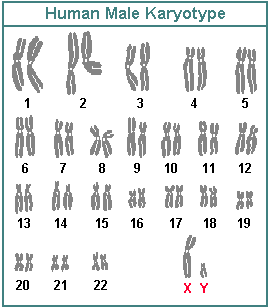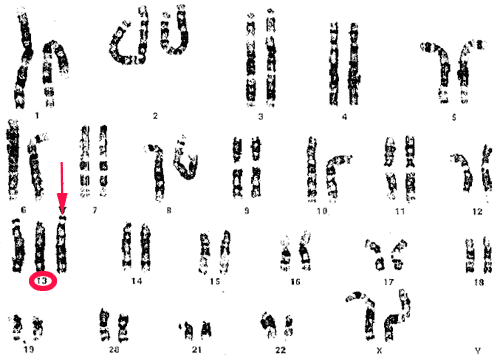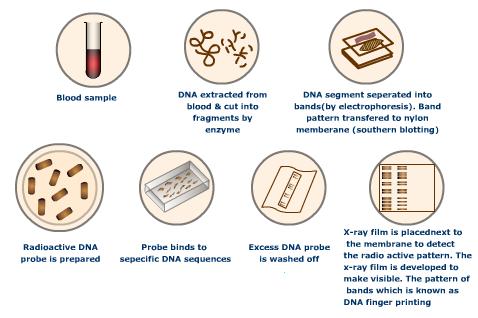1. STRUCTURE AND COMPOSITION OF DNA
• CHOROMOSOME STRUCTURE:
In the nucleous of each cell, the DNA molecule is packaged into thread like structures called chromosomes. Each chromosome is made up of DNA tightly coiled many times around proteins called histones that support its structure. They are not visible even under a microscope.
Each chromosome has a constriction point called centromere, which divides the chromosome into two sections, or arms. The short arm of the chromosome is labeled the p arm. The long arm of the chromosome is labeled the q arm. The location of the centromere on each chromosome gives the chromosome its characteristic shape, and can be used to help describe the location of specific genes.
Almost all the analyses of the chromosomes are during the mitotic metaphase. During that phase of the cell cycle, DNA has been replicates and the chromatin is highly condensed. The Centromere is the structure where the mitotic spindle attaches prior to segregation.
 The centromere can be established anywhere, if it is in the centre it is called metacentric, if it is a little bit up in the center it is called submetacentric, if it is close to the end of each chromosome it is called acrocentric and finally if it is at the end it is called telocentric.
The centromere can be established anywhere, if it is in the centre it is called metacentric, if it is a little bit up in the center it is called submetacentric, if it is close to the end of each chromosome it is called acrocentric and finally if it is at the end it is called telocentric.
Talking about this theme it would be better to understand for you if you can watch this video. This video was made by Dr. Stephen Sullivan.
What is DNA?
Deoxyribonucleic acid is a nucleic acid that contains the genetic instructions used in the development and functioning of all known living organisms and some viruses. The main role of DNA molecules is the long-term storage of information. DNA is often compared to a set of blueprints, like a recipe or a code, since it contains the instructions needed to construct other components of cells, such as proteins and RNA molecules.
The DNA segments that carry this genetic information are called genes, but other DNA sequences have structural purposes, or are involved in regulating the use of this genetic information.
The information in DNA is stored as a code made up of four chemical bases: adenine (A), guanine (G), cytosine (C), and thymine (T). Human DNA consists of about 3 billion bases, and more than 99 percent of those bases are the same in all people. The order, or sequence, of these bases determines the information available for building and maintaining an organism, similar to the way in which letters of the alphabet appear in a certain order to form words and sentences.
 DNA bases pair up with each other, A with T and C with G, to form units called base pairs. Each base is also attached to a sugar molecule and a phosphate molecule. Together, a base, sugar, and phosphate are called a nucleotide. Nucleotides are arranged in two long strands that form a spiral called a double helix. The structure of the double helix is somewhat like a ladder, with the base pairs forming the ladder’s rungs and the sugar and phosphate molecules forming the vertical sidepieces of the ladder.
DNA bases pair up with each other, A with T and C with G, to form units called base pairs. Each base is also attached to a sugar molecule and a phosphate molecule. Together, a base, sugar, and phosphate are called a nucleotide. Nucleotides are arranged in two long strands that form a spiral called a double helix. The structure of the double helix is somewhat like a ladder, with the base pairs forming the ladder’s rungs and the sugar and phosphate molecules forming the vertical sidepieces of the ladder.
An important property of DNA is that it can replicate, or make copies of itself. Each strand of DNA in the double helix can serve as a pattern for duplicating the sequence of bases. This is critical when cells divide because each new cell needs to have an exact copy of the DNA present in the old cell.
.png) Knowing what DNA is composed of is only half of the mystery, as scientists still could not work out the physical structure of the molecule.
Knowing what DNA is composed of is only half of the mystery, as scientists still could not work out the physical structure of the molecule.
What is a nucleotide?
 Nucleotides are molecules that, when joined together, make up the structural units of RNA and DNA. In addition, nucleotides play central roles in metabolism. In that capacity, they serve as sources of chemical energy (adenosine triphosphate and guanosine triphosphate), participate in cellular signaling (cyclic guanosine monophosphate and cyclic adenosine monophosphate), and are incorporated into important cofactors of enzymatic reactions (coenzyme A, flavin adenine dinucleotide, flavin mononucleotide, and nicotinamide adenine dinucleotide phosphate).
Nucleotides are molecules that, when joined together, make up the structural units of RNA and DNA. In addition, nucleotides play central roles in metabolism. In that capacity, they serve as sources of chemical energy (adenosine triphosphate and guanosine triphosphate), participate in cellular signaling (cyclic guanosine monophosphate and cyclic adenosine monophosphate), and are incorporated into important cofactors of enzymatic reactions (coenzyme A, flavin adenine dinucleotide, flavin mononucleotide, and nicotinamide adenine dinucleotide phosphate).
What is a gene?
 A gene is a unit of heredity in a living organism. It is normally a stretch of DNA that codes for a type of protein or for an RNA chain that has a function in the organism. All living things depend on genes, as they specify all proteins and functional RNA chains. Genes hold the information to build and maintain an organism's cells and pass genetic traits to offspring. A modern working definition of a gene is "a locatable region of genomic sequence, corresponding to a unit of inheritance, which is associated with regulatory regions, transcribed regions, and or other functional sequence regions ".
A gene is a unit of heredity in a living organism. It is normally a stretch of DNA that codes for a type of protein or for an RNA chain that has a function in the organism. All living things depend on genes, as they specify all proteins and functional RNA chains. Genes hold the information to build and maintain an organism's cells and pass genetic traits to offspring. A modern working definition of a gene is "a locatable region of genomic sequence, corresponding to a unit of inheritance, which is associated with regulatory regions, transcribed regions, and or other functional sequence regions ".
- Structure:
There are two general types of gene in the human genome: non-coding RNA genes and protein-coding genes.
Non-coding RNA genes represent 2-5 per cent of the total and encode functional RNA molecules. Many of these RNA's are involved in the control of gene expression, particularly protein synthesis. They have no overall conserved structure.
Protein-coding genes represent the majority of the total and are expressed in two stages: transcription and translation (see Gene expression). They show incredible diversity in size and organisation and have no typical structure. There are, however, several conserved features.
-Composition:
Due to the chemical composition of the pentose residues of the bases, DNA strands have directionality. One end of a DNA polymer contains an exposed hydroxyl group on the deoxyribose; this is known as the 3' end of the molecule. The other end contains an exposed phosphate group; this is the 5' end. The directionality of DNA is vitally important to many cellular processes, since double helices are necessarily directional (a strand running 5'-3' pairs with a complementary strand running 3'-5'), and processes such as DNA replication occur in only one direction. All nucleic acid synthesis in a cell occurs in the 5'-3' direction, because new monomers are added via a dehydration reaction that uses the exposed 3' hydroxyl as a nucleophile.
 One of the most important developments is the discovery of the double helix structure of DNA, made in 1953 by Watson and Crick biologist, a discovery that caused the foundations of modern molecular biology. Actually this is a discovery of great importance to a lot of new processes. The contents of this information have been shown to depend on the order in which they have different types of nucleic acids to form DNA strands. This sequence is read the same way as you read various letters of the alphabet that make up a word, and are interpreted as a set of rules apply to all living beings and recently discovered which are called the human genome or genetic code. Other significant progress made in the field of genetics is the discovery of mutation sands their influence on living beings.
One of the most important developments is the discovery of the double helix structure of DNA, made in 1953 by Watson and Crick biologist, a discovery that caused the foundations of modern molecular biology. Actually this is a discovery of great importance to a lot of new processes. The contents of this information have been shown to depend on the order in which they have different types of nucleic acids to form DNA strands. This sequence is read the same way as you read various letters of the alphabet that make up a word, and are interpreted as a set of rules apply to all living beings and recently discovered which are called the human genome or genetic code. Other significant progress made in the field of genetics is the discovery of mutation sands their influence on living beings.




.png)























.gif)

.jpg)







